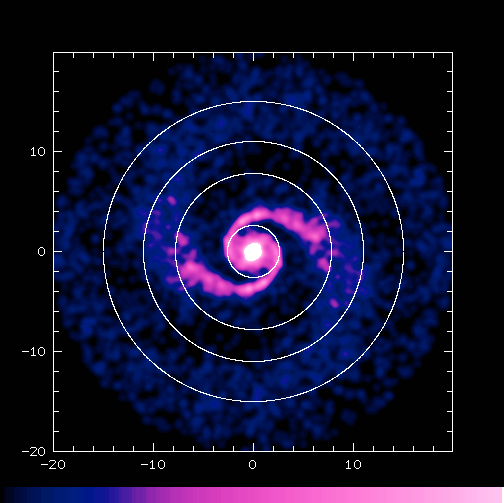 |
|
The value of the pattern speed of density waves (or equivalent the location of the main resonances) is still an unresolved issue for several types of spiral galaxies. The exact estimation of this value is very important for the understanding of the spiral structure but cannot be measured directly. Usually it is estimated by associating major resonances (e.g. 4:1, corotation or -2:1) to spiral features such as the end of the arms. The figure below is from a work done in collaboration with D. Kaufmann (Patsis and Kaufmann 1999). In N-body simulations of galactic disks where a main bisymmetric spiral mode dominates for 5-7 pattern rotations of the spiral we considered the phases of the dominating bisymmetric spiral for the saved snapshots during this period. Then the resulting diagrams have been rotated with the found pattern speed of the spiral so that they can be overplotted in a single frame. Such a result is depicted below. The numbers on the axes correspond to kpc. |

The circles represent the 2:1, 4:1, corotation, and -2:1 resonances. It is clear that the spiral we found rotates as slow as to put corotation beyond the end of the strong symmetric spiral. The strong symmetric part of the spiral ends at the inner 4:1 resonance, and only a weaker extension reaches resonances beyond it. Contopoulos and Grosbol (1986;1988) indicated that strong open spirals terminate at the inner 4:1 resonance, due to the abrupt change of the orientation of the x1 orbits at the region of this resonance. Patsis, Contopoulos and Grosbol (1991) found that the self-consistency of orbital models for
Sa and Sb galaxies (relation between imposed and response density) was better if a strong symmetric spiral
was assumed ending at the 4:1 resonance, than in models where the end of the strong symmetric part was
placed at corotation. Later (see Hydrodynamics, SPH simulations by Patsis, Hiotelis, Contopoulos and Grosbol (1994) and Patsis, Grosbol and Hiotelis (1997) have shown that gaseous response models could reproduce a spiral structure along the potential minima of the imposed spiral up to the inner 4:1 resonance. A major role for the reproduction of morphological features observed in grand design spiral galaxies plays the inclusion of an m=1 component in the imposed potential (Patsis et al. 1997). REFERENCES
|